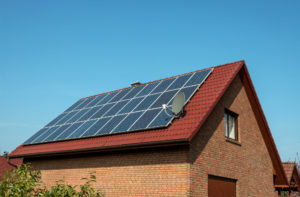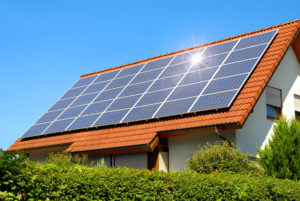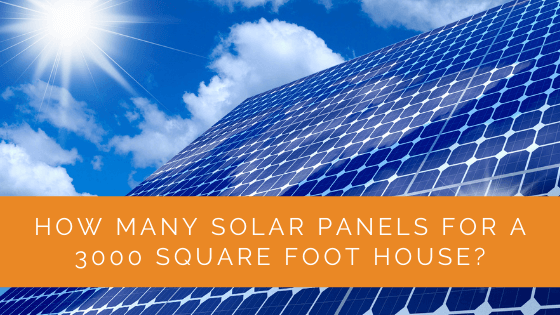How many solar panels do I need for my home? If you are often left wondering this question, you are not alone. When it comes to introducing new technology like solar power, it is quite natural to feel concerned. Not only is the efficiency of the solar system, but also the cost is associated with this.
Also, by finding out how many solar panels you need, you can figure out if a solar installation is a sensible step for your home.
Now, there are ways to analyze and calculate this. However, you need to consider many factors other than just the size of the house. A single solar panel will not do you any good, even as a general rule. Only after installing many solar panels can you reap the benefits of solar energy systems. More numbers will add to higher efficiency when it comes to solar panels.
Contents
- 1 Key Takeaways
- 2 Factors That Determine the Number of Solar Energy Systems You Might Need
- 3 Calculate the Panel Wattage
- 4 Case Study: Solar Panel Installation
- 5 Expert Insights from Our Solar Panel Installers About How Many Solar Panels Are Needed for a 3000 Square Foot House
- 6 Experience Solar Excellence with Us!
- 7 Conclusion
Key Takeaways
- The number of solar panels needed for a 3000 square foot house depends on various factors, including the average electricity usage of your home, the energy produced by the solar system, the panel wattage, and the size of the solar panel system.
- To estimate the number of solar panels required, you can calculate based on an average of 30 watts per square foot. For a 3000 square foot home, this could mean needing between 17 and 26 solar panels.
- Other factors like roof shading, roof direction, and the type of solar panel chosen, as well as whether you opt for a system with batteries, also impact the number of panels required, and it’s advisable to consult with a professional for an accurate estimate.
Factors That Determine the Number of Solar Energy Systems You Might Need
Thinking that size of the solar panel system alone will help you configure the issue is a misconception. Various factors, like your solar energy system requirement, panel wattage, and size of the solar panels, determine the number. If you really want to understand how many solar panels you need for a 3000 sq. ft. house, then you need to understand each of them.
Average Electricity Usage of Your Home
It’s simple, the more renewable energy you use, the more panels you will need. Understanding the energy requirement is the primary criterion when installing solar power generated at your home. When it comes to solar panel system installation, the kWh usage of your house is the most accurate determiner since energy usage is calculated using this measure. You can find it out from your monthly electricity bill.
Now, household energy usage varies during winter and summer. Therefore, it is better to calculate the system design based on the past year’s electricity usage cost. This will help you understand the ups and downs of the usage more accurately. For instance, in a typical American household, there is an annual electric use of around 10 715 kWh.
Now, that makes the typical usage of a single-bedroom house around 1.94 W. This can either be fulfilled via six solar arrays producing 375W of energy or seven panels producing 315 W. The table below can give you a clearer perception of this.
| Bedrooms | Typical System Size | No. of Panels (372W) | No. of Panels (372W) |
|---|---|---|---|
| 1 | 1.94 kW | 6 | 7 |
| 2 | 3.88 kW | 11 | 13 |
| 3 | 5.82 kW | 16 | 19 |
| 4 | 7.75 kW | 21 | 25 |
| 5 | 9.69 kW | 26 | 31 |
| 6 | 11.63 kW | 32 | 37 |
Number of Solar Panels Based on Your Monthly Electricity Bills
If your energy cost is estimated according to the national Average Electricity Rate, it should be around $13.3/ kWh. The Average Electricity Rate of the U.S. is $14.12, as per recent statistics.
Of course, this amount will vary depending on your appliances as well. The cost will be less for houses in the United States that use home heating only a few times a year. However, in colder weather, this cost can increase for months. Homes can reduce costs by opting for natural gas or electric resistance heating. So, the electricity usage and monthly fee depend greatly on where you live and what appliances you use.
You can get a rough estimate of this from the table below.
| Region | Kilowatt-hours | Solar panels needed |
|---|---|---|
| Northeast | 484 | 14-15 |
| Midwest | 797 | 14-17 |
| South (South Atlantic and Gulf Coast) | 1,158 | 19-24 |
| West (Mountains/Pacific) | 710 | 13-18 |
Energy Produced by the Solar System
This also brings us to the point of the energy produced by solar panels. This will depend a lot on the area you live in since solar panels rely on how much sunlight they receive.
Usually, you can find the peak sun hours in your area, which tells you about how much sun intensity in your locality. Since the U.S. has a large geographic territory, different areas might fall under other climate conditions.
The daily peak sun hours’ number denotes how much sunlight your panels can receive daily. However, you can calculate the monthly cost, multiplying it by 30. This will tell you how many kWh of electricity the solar panels can produce daily.
For instance, if your area has monthly peak sunlight hours of 150, then a 1kW solar panel can provide 150kW of electricity in a month. This will also tell you how many 1kW solar panels you need to install.

Calculate the Panel Wattage
The panel wattage of a solar panel is also known as its power rating. This tells you about how much energy your solar panels can produce. With constant innovation, most solar panels can make about 320 W. This helps reduce the required number, and your home can function with fewer panels if they have a high wattage rating.
Size of the Solar Panel System
The next factor that you need to consider is the size of the solar panel. This is where your utility bill comes in handy, as it is the easiest way to do it. Once you know the amount of power you need to pull from the grid, you can decide on the size of the solar panel. If you install bigger solar panels, the number of panels will decrease and vice versa.
Make sure to take every appliance in your home into account while doing this to make a more accurate assumption. However, it is only an estimate and can vary during the actual installation. Apart from the energy usage, the duration of sunlight will also impact this. In general, a typical household in North America requires about 30 watts per sq. ft annually.
Number of Solar Installation Based on Square Footage
Now it comes down to the number of panels you require. After taking the basic energy usage and size of the panels into account, you can finally focus on the number of panels you need.
How Many Solar Panels Do I Need for a 3000 Sq. Ft. House?
Based on the previous analysis, you can calculate the number with 30 watts per square feet average calculation in mind. Therefore, it can be assumed that for a 3000 sq. ft. home, you will require 17 and 26 solar panels.
Of course, some factors like the cost savings and federal tax credits will give you a big return on investment. Systems installed between 2022 and 2032 are eligible for a 30% credit, while those installed in 2033 and 2034 receive 26% and 22%, respectively. The tax credit expires starting in 2035 unless Congress renews it.
There is another way to save cost, though. If you install solar panels that are premium or budget, you can get them at a lesser cost no matter how much electricity you need. For instance, about 30 premium solar panels can generate enough electricity to power a house.
Or, you can go for a budget solar panel with an energy efficiency rating of 250 W. Therefore, a 30000 sq. ft home that requires 1,185-kilowatt hours monthly electricity can function with 30 to 46 budget panels.
How Many Solar Panels You Need: Based on Number of Bedrooms?
Apart from the size of your home, even the number of bedrooms is an essential factor for deciding the number of panels. This is also helpful if you are not aware of the square footage of your house.
You can still figure out how many solar panels you need from the number of bedrooms you have. This is estimated by the National Association of Homebuilders, one of the biggest trade associations in the country.
According to their report, there are approximately 3.38 bedrooms in an average American household. You can take reference from the table above and calculate the average energy usage of the average American home.
How Many Solar Panels You Need: Based on Measurement of the Roof Space?
Besides the sq footage of your home and the number of bedrooms, also the roof space decides the number of solar panels. The average installation will need a roof space of about 335 to 405 square feet.
If you go for a higher number of solar panels or choose more oversized panels, the measurement may increase. That is why it is necessary to know the roof space requirement when opting for solar energy installation.
You can do this after you have decided on the number of panels. The easiest way to calculate this is to multiply the number of solar panels needed by 17.55 square feet. This is the average space required for installing a solar system in houses today.
Therefore, it is better for those with limited roof space capacity to go for higher efficiency models. This will help reduce the number of panels and require less space. For instance, you will need 220 sq. feet of area to install thirteen 4-kilowatt hours solar panels.

Case Study: Solar Panel Installation
Background
The Kimura family, residing in Honolulu, Hawaii, decided to transition to solar energy to reduce their electricity bills and contribute to environmental sustainability. With an average electricity consumption of 1,000 kWh per month, they needed a comprehensive solution to meet their energy needs efficiently.
Project Planning and Objectives
The primary objectives were to reduce the Kimura family’s reliance on the grid, lower their electricity bills, and harness Hawaii’s abundant sunlight. Solar Panels Network USA was tasked with assessing their homes and providing a tailored solar panel solution.
Installation and Costs
After a detailed evaluation, a 10kW solar panel system was recommended for the Kimura home. The breakdown of costs includes:
- Solar Panels: $15,000
- Installation: $4,000
- Inverter and Battery: $3,000
- Permits and Inspections: $1,000
- Total Estimated Cost: $23,000
Financial Incentives:
- Federal Tax Credit (ITC): $6,900
- State Rebates: $2,000
- Adjusted Total Cost: $14,100
Installation Process
The installation was completed over three days and included the following steps:
- Site Assessment: Evaluating the roof space, shading, and orientation for optimal panel placement.
- Panel Installation: Mounting 30 high-efficiency solar panels on the south-facing roof.
- System Integration: Connecting the panels to a high-efficiency inverter and a battery for energy storage.
- Inspection and Activation: Conducting a final inspection and system activation to ensure optimal performance.
Results and Benefits
The Kimura family’s solar power system now generates approximately 1,200 kWh per month, exceeding their average consumption and allowing them to feed excess energy back into the grid. This not only reduced their electricity bills to virtually zero but also provided additional savings through net metering.
Environmental and Financial Impact:
- Annual Savings: $3,600
- Payback Period: ~4 years
- Reduced CO2 Emissions: ~4 metric tons annually
- Enhanced Energy Independence: The family experienced fewer disruptions and a significant reduction in energy costs.
Summary
The Kimura family’s experience in Honolulu, Hawaii, highlights the effectiveness of a well-planned solar panel installation. By leveraging Hawaii’s ample sunlight and state incentives, they achieved substantial financial savings and reduced their carbon footprint. The project demonstrates the importance of considering factors such as energy consumption, panel efficiency, and installation conditions to optimize the benefits of solar energy. Solar Panels Network USA’s expertise ensured a smooth installation process, setting a benchmark for sustainable living in Hawaii.
Expert Insights from Our Solar Panel Installers About How Many Solar Panels Are Needed for a 3000 Square Foot House
When determining the number of solar panels needed for a 3000 square foot house, it’s essential to consider your home’s specific energy consumption. Typically, a thorough analysis of your past year’s electricity bills will give a more accurate estimate of the panels required.
Panel wattage plays a crucial role in calculating the number of panels you need. Higher wattage panels can generate more electricity, which means you might need fewer panels overall. Always consult with a professional to understand the best options for your home.
Factors such as roof space, shading, and orientation are critical in determining the efficiency of your solar system. Ensuring that your panels receive maximum sunlight without obstructions will help in achieving optimal energy production.
Experience Solar Excellence with Us!
Trust in Solar Panels Network USA, where our seasoned experts deliver top-quality solar solutions for homes and businesses nationwide. With a legacy of countless successful installations and a commitment to sustainable energy, we’re your reliable partner in the solar journey. Ready for a brighter, eco-friendly future? Call us now at (855) 427-0058 and harness the power of the sun!
Conclusion
Other than the factors mentioned above, you will also need to consider the roof shading, the direction of the roof, and the type of solar panel you choose. A solar system with batteries has a better chance of storing the energy longer.
This will also impact the number of panels you need. Also, you need to decide whether you are paying for the system upfront, as this will cost a considerable amount.
However, doing so will completely remove the need to pay monthly utility bills. In the end, you may need an average of 30 high-capacity solar panels for your 3000 sq. ft home. It is better to get your requirements analyzed by a professional who will consider all factors to give you a correct estimate.
About the Author
Solar Panels Network USA stands at the forefront of solar energy solutions, driven by a team of seasoned solar engineers and energy consultants. With over decades of experience in delivering high-quality solar installations and maintenance, we are committed to promoting sustainable energy through customer-centric, tailored solutions. Our articles reflect this commitment, crafted collaboratively by experts to provide accurate, up-to-date insights into solar technology, ensuring our readers are well-informed and empowered in their solar energy decisions.

